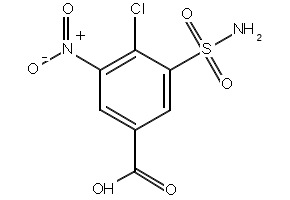4-Chloro-3-nitro-5-sulphamoylbenzoic acid CAS#: 22892-96-2; ChemWhat Code: 24308
Identification
| Product Name | 4-Chloro-3-nitro-5-sulphamoylbenzoic acid |
| IUPAC Name | 4-chloro-3-nitro-5-sulfamoylbenzoic acid |
| Molecular Structure |  |
| CAS Registry Number | 22892-96-2 |
| EINECS Number | 245-310-9 |
| MDL Number | MFCD00058688 |
| Beilstein Registry Number | No data available |
| Synonyms | 4-chloro-3-nitro-5-sulfamoylbenzoic acid2-chloro-3-nitro-5-carboxy-benzenesulphonamide |
| Molecular Formula | C7H5ClN2O6S |
| Molecular Weight | 280.65 |
| InChI | InChI=1S/C7H5ClN2O6S/c8-6-4(10(13)14)1-3(7(11)12)2-5(6)17(9,15)16/h1-2H,(H,11,12)(H2,9,15,16) |
| InChI Key | ACYLUAGCBGTEJF-UHFFFAOYSA-N |
| Canonical SMILES | c1c(cc(c(c1[N+](=O)[O-])Cl)S(=O)(=O)N)C(=O)O |
| Patent Information | ||
| Patent ID | Title | Publication Date |
| WO2019/193159 | BUMETANIDE DERIVATIVES FOR THE THERAPY OF HYPERHIDROSIS | 2019 |
| US2014/128469 | DEUTERATED N-BUTYL BUMETANIDE | 2019 |
Physical Data
| Appearance | Off-white to light beige powder |
| Solubility | No data available |
| Flash Point | No data available |
| Refractive index | No data available |
| Sensitivity | No data available |
| Melting Point, °C |
| 235 – 236 |
| 235 – 236.5 |
Spectra
| No data available |
Route of Synthesis (ROS)
| Conditions | Yield |
| With sodium hydrogencarbonate In water at 85℃; | 57% |
| With sodium hydrogencarbonate In water at 85℃; for 15h; | 38% |
| With sodium hydrogencarbonate In water |
Safety and Hazards
| Pictogram(s) |  |
| Signal | Warning |
| GHS Hazard Statements | H315 (100%): Causes skin irritation [Warning Skin corrosion/irritation] H319 (100%): Causes serious eye irritation [Warning Serious eye damage/eye irritation] H335 (100%): May cause respiratory irritation [Warning Specific target organ toxicity, single exposure; Respiratory tract irritation] Information may vary between notifications depending on impurities, additives, and other factors. |
| Precautionary Statement Codes | P261, P264, P264+P265, P271, P280, P302+P352, P304+P340, P305+P351+P338, P319, P321, P332+P317, P337+P317, P362+P364, P403+P233, P405, and P501 (The corresponding statement to each P-code can be found at the GHS Classification page.) |
Other Data
| Transportation | NONH for all modes of transport |
| Under the room temperature and away from light | |
| HS Code | No data available |
| Storage | Under the room temperature and away from light |
| Shelf Life | 1 year |
| Market Price | USD |
| Druglikeness | |
| Lipinski rules component | |
| Molecular Weight | 280.645 |
| logP | 0.61 |
| HBA | 5 |
| HBD | 2 |
| Matching Lipinski Rules | 4 |
| Veber rules component | |
| Polar Surface Area (PSA) | 151.66 |
| Rotatable Bond (RotB) | 3 |
| Matching Veber Rules | 1 |
| Use Pattern |
| As a pharmaceutical intermediate, it can be used to synthesize various drug molecules, especially those with antibacterial, antiviral or anti-inflammatory effects. It can also be used as a pesticide intermediate to synthesize pesticide compounds with specific biological activities, such as herbicides, insecticides or fungicides. It may be used to synthesize dyes and pigments, which may have special colors or other physical and chemical properties. As a precursor of functional materials, it can be used to prepare materials with specific physical or chemical properties, which may have applications in electronics, optoelectronics or other high-tech fields. |
Buy Reagent | |
| No reagent supplier? | Send quick inquiry to ChemWhat |
| Want to be listed here as a reagent supplier? (Paid service) | Click here to contact ChemWhat |
Approved Manufacturers | |
| Caming Pharmaceutical Ltd | http://www.caming.com/ |
| Want to be listed as an approved manufacturer (Requires approvement)? | Please download and fill out this form and send back to approved-manufacturers@chemwhat.com |
Other Suppliers | |
| Watson International Limited | Visit Watson Official Website |
Contact Us for Other Help | |
| Contact us for other information or services | Click here to contact ChemWhat |


